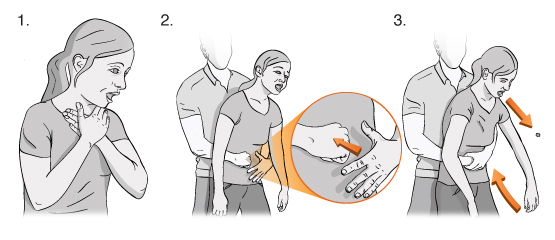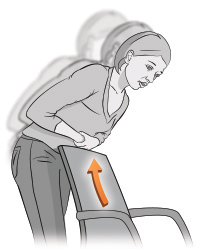Choking and Abdominal Thrusts
Choking and Abdominal Thrusts
When food or some other foreign object becomes stuck in the airway it can cause choking. Choking prevents oxygen from getting to the lungs and the brain. Lack of oxygen to the brain for more than 4 minutes may cause brain damage or death. It is important for all people to recognize and know how to handle choking at home and in public places. Experts recommend using abdominal thrusts to treat someone who is choking.
How can I prevent choking?
You can prevent choking in adults with these precautionary measures:
-
Cut food into small pieces.
-
Chew food slowly and thoroughly, especially if wearing dentures.
-
Don't laugh and talk while chewing and swallowing.
-
Don't drink lots of alcohol before and during meals.
You can prevent choking in infants and children with these precautionary measures:
-
Keep marbles, beads, thumbtacks, latex balloons, coins, and other small toys and objects out of reach, particularly in children younger than 4 years old.
-
Prevent children from walking, running, or playing when they have food and toys in their mouth.
-
Youngsters younger than age 4 should not be fed foods that can easily become lodged in the throat, such as hot dogs, nuts, chunks of meat or cheese, grapes, hard or sticky candy, popcorn, chunks of peanut butter, or raw carrots.
-
Supervise mealtimes with young children.
-
Prevent older siblings from giving a dangerous food or toy to a young child.
What is the recommended first-aid technique for choking?
A series of under-the-diaphragm abdominal thrusts are recommended for a person who is choking on a piece of food or a foreign object. This technique is used only when a person is choking due to something blocking the airway. Choking is when a person can't speak, cough, or breathe. An airway obstruction can lead to a loss of consciousness and death. When applying the abdominal thrusts, be careful not to use too much force so you don't damage the ribs or internal organs. Only use abdominal thrusts on a conscious person if "back slaps" fail to relieve the airway obstruction. If the person is unconscious, use chest compressions.
Abdominal thrusts lift the diaphragm. They force enough air from the lungs to create an artificial cough. This cough helps move air through the windpipe, pushing, and expelling the obstruction out of the airway and mouth:

-
Reach around the person's waist.
-
Position one clenched fist above the navel (belly button) and below the rib cage.
-
Grasp your fist with your other hand. Pull the clenched fist sharply and directly backward and upward under the rib cage 6 to 10 times quickly.
-
If the person is obese or in late pregnancy, give chest thrusts.
-
Continue uninterrupted until the obstruction is relieved or advanced life support is available. In either case, the person should be examined by a healthcare provider as soon as possible.

If you are by yourself and choking, you can perform thrusts on yourself. Or thrust your upper abdomen against the back of a chair or the edge of a counter.
Abdominal thrusts can be painful and even injure the person. Only use abdominal thrusts in actual emergencies, when it is certain that the person is choking. Use this method only in adults.
A different technique is used in infants and small children. Discuss the proper first-aid choking technique for your child with his or her healthcare provider.
How can I learn the right way to help someone who is choking?
Using abdominal thrusts is simple to learn. It is often taught during first-aid and cardiopulmonary resuscitation (CPR) classes. Contact your local chapter of the American Red Cross or American Heart Association. Or contact your local hospital or healthcare facility for a class schedule and more information.
Updated:
May 03, 2019
Sources:
Adult Basic Life Support and CPR Quality, American Heart Association
Reviewed By:
Eric Perez MD,Ronald Karlin MD,Daphne Pierce-Smith RN MSN CCRC